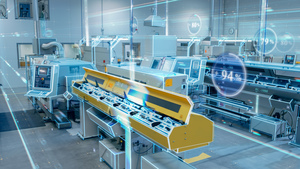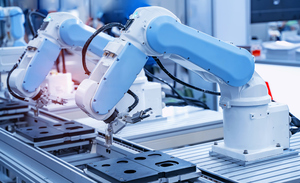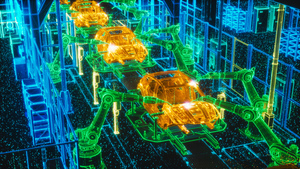
 |
Charlotte Stonestreet
Managing Editor |
| Home> | IIot & Smart Technology | >Big Data | >Accelerating Edge AI implementation |
| Home> | IIot & Smart Technology | >Industry 4.0 | >Accelerating Edge AI implementation |
Accelerating Edge AI implementation
16 October 2025
AI is no longer a futuristic idea for manufacturers but a present-day necessity. As companies move from pilots to large-scale adoption, the question has shifted from 'Why AI?' to 'How to implement it effectively?'. For many, the answer is Edge AI, asserts Matthias Huber

UNLIKE CLOUD-based AI, Edge AI processes information locally, offering clear advantages. Edge AI eliminates network latency, enabling real-time decision-making in areas such as quality control, predictive maintenance, process automation, and safety monitoring. Edge AI also reduces bandwidth consumption by transmitting insights rather than raw data. Most importantly for manufacturers, it keeps sensitive production data on site.
Edge AI encompasses two types of AI: predictive AI and generative AI. Predictive AI analyses historical data to forecast future events. For example, AI can help create safer manufacturing work environments by predicting potential hazards or ensuring compliance. In automated quality inspection, production lines can continuously be monitored using Edge AI for real-time insights for quality control and significantly reduce the risks of defects.
Generative AI captures patterns and trends in historical data and creates new data and content based on that understanding. Generative AI, or GenAI, can be employed in manufacturing environments to aid the development of new products, enhance digital simulations, and enable users to analyse complex data in new ways.
The key technical characteristic that enables Edge AI is separating training from inference. Although training large AI models still requires substantial data center resources, the inference phase, in which AI applies what it has learned to new data, is far less demanding. Thanks to advances in processor design and AI accelerators, complex inference workloads can now be carried out on compact, energy-efficient edge servers. This makes sophisticated intelligence practical on the factory floor.
From vision to value: Edge AI in action on the factory floor
Manufacturers recognise the value of Edge AI in its ability to analyse data in real time and trigger immediate, automated responses. Machine vision, for example, has become integral to modern quality assurance. While traditional inspection systems might sample one in twenty parts for defects, Edge AI-powered vision systems can inspect every single part as it comes off the production line. These systems cannot only detect defects instantly but also identify subtle variations in quality that may signal emerging process issues, enabling action to be taken automatically before defects occur and minimising costly downtime.
The impact is measurable. According to McKinsey, the adoption of Industry 4.0 technologies - including AI, advanced analytics, and the Internet of Things (IoT) - can reduce machine downtime by 30 to 50 percent as well as reduce quality-related costs by 10 to 20 percent []. These improvements are not limited to quality control. Predictive maintenance, powered by Edge AI, allows manufacturers to move beyond rigid maintenance schedules. Instead, AI continuously monitors equipment, learning to recognise the early signs of wear or failure. In process automation, it facilitates rapid decision-making, enhances operational agility, and streamlines workflows.
Workplace safety is also an area where Edge AI is making a difference. By analysing data from security cameras, machinery, and operational software, AI systems can identify hazardous situations in real-time, such as workers approaching moving equipment too closely, and recommend or even initiate corrective actions. Edge AI is the only technology capable of instantly processing and acting on large volumes of video and sensor data.
Infrastructure matters: Building for reliability and longevity
As manufacturers transition from pilot projects to production-scale Edge AI, the choice of infrastructure becomes critical. Unlike office IT, manufacturing environments require systems that can operate reliably for years, often in challenging conditions. While standard servers may suffice in some settings, many applications require ruggedised hardware that can withstand temperature extremes, dust, vibration, and shock. Fanless designs are often favoured in dusty environments to minimise maintenance needs and reduce the risk of failure.
Reliability is paramount. Metrics such as mean time between failures (MTBF) and the ability to upgrade or reconfigure systems over time should be carefully considered. Modular server architectures, like those offered by Supermicro, enable manufacturers to customise systems according to their specific workload and environmental needs. This modularity also provides a clear path for future upgrades, ensuring that infrastructure investments remain viable as AI workloads evolve.
Selecting the right AI accelerators should be a key decision. Graphics processing units (GPUs) are the most common type of AI accelerator, and various specialised GPUs are available to address the diverse needs of Edge AI workloads in manufacturing. To ensure optimal performance and support for the intended applications, compatibility between server platforms and AI accelerators must be verified.
Overcoming implementation challenges
Despite the clear benefits, implementing Edge AI is not without its challenges. Manufacturing environments often have space, power, and cooling constraints. Edge servers must be compact, energy-efficient, and able to operate in less-than-ideal conditions. Another hurdle is data management: the sheer volume and diversity of data generated on the factory floor can overwhelm traditional IT systems. Efficient local processing, storage, and robust security are essential.
When considering management, it is important to note that edge deployments are usually spread out over several sites and often lack adequate on-site IT support. The infrastructure must therefore support remote monitoring, updates, and troubleshooting to minimise downtime and operational disruption.
Integrating with existing systems is also often a stumbling block. AI solutions must interface with legacy machinery, manufacturing execution systems (MES), and safety protocols. Careful planning is required as well as the use of software development kits (SDKs) and pre-built modules that simplify integration and accelerate time to value.
Supermicro and NVIDIA: Proven solutions for manufacturing
In close collaboration with NVIDIA, Supermicro has developed a portfolio of Edge AI solutions designed to meet the demands of manufacturing environments. This comprehensive, full-stack approach combines modular, ruggedised server hardware with support for the latest NVIDIA AI accelerators.
Supermicro’s systems cover a wide range of form factors and performance levels. They range from compact, fanless edge servers for space-constrained environments to high-performance, multi-GPU systems that can handle the most demanding AI workloads on the factory floor. These systems are designed to work seamlessly with NVIDIA accelerators. Each is tailored for specific AI inference and generative tasks.
As an example, Supermicro’s ARS-E103-JONX is ideally suited for advanced edge applications in manufacturing, logistics and other industries. It comprises the NVIDIA Jetson Orin NX, the most advanced AI computer for applications and processes that require low-power, high-performance data inferencing. Delivered in a compact, fanless form factor, the system allows 157 TOPS for multiple concurrent AI pipelines with a versatile set of high-speed IO interface options, including 5G and Wi-Fi.
Other systems range from compact fanless systems to powerful box PCs and rackmount edge systems, capable of deploying multiple GPU accelerators such as the NVIDIA RTX PRO 6000 Blackwell Server Edition or NVIDIA H200 NVL. Each model has distinctive use cases based on the type and volume of data being processed, as well as deployment factors such as size and power consumption. Selecting the right hardware, therefore, includes identifying which AI accelerator is required and ensuring the server platform is compatible.
The software stack is equally critical. NVIDIA AI Enterprise provides manufacturers with optimized frameworks, libraries, and tools that ensure efficient AI inference and seamless integration into existing workflows. Those developing custom applications will find that the availability of SDKs and pre-built modules further accelerates development and reduces complexity, enabling faster time-to-value for AI-driven manufacturing solutions.
Best practices for a successful Edge AI journey
When implementing Edge AI, manufacturers should start with clearly defined use cases and measurable goals. They ought to select infrastructure that is reliable, modular, and compatible with the necessary AI accelerators. Manufacturers must also consider environmental factors, such as temperature, dust, and vibration, and design systems that allow for remote management and easy integration with existing processes.
Most importantly, manufacturers should view Edge AI as a journey, not a destination. The ability to upgrade and adapt infrastructure over time is essential, given that AI technologies and manufacturing needs are constantly evolving. Investing in robust, modular infrastructure and proven solutions from trusted partners can accelerate manufacturers' AI journeys, helping them achieve greater efficiency, quality, and competitiveness in an increasingly digital world.
Matthias Huber is senior director, solutions manager, IoT/ embedded and edge computing at Supermicro
- Centre of Excellence in emerging digital technologies opens in Liverpool
- SPE Offshore Europe looks to the future
- Smarter working in utilities & water
- How robots can make manufacturing plants more efficient
- Emerson roadshow hits the UK
- PROGRAM EASES PUMP SELECTION
- Tech start-up to half the cost of CNC machined parts
- Engineered to reduce emissions & operating costs
- Change management a priority for additive manufacturing
- MIT engineers design bionic heart
- Industry 4.0 ready
- Intelligent interlocks
- The digital future has begun
- The smart future of manufacturing
- Partnership integrates freight & warehouse management
- Secure data handling
- When & where will Industry 4.0 actually happen?
- Education key to unlocking I4.0
- Trelleborg joins Smart Data Innovation Lab
- How well is your smart farm running?






















